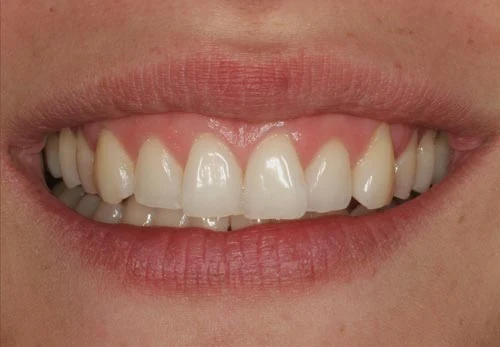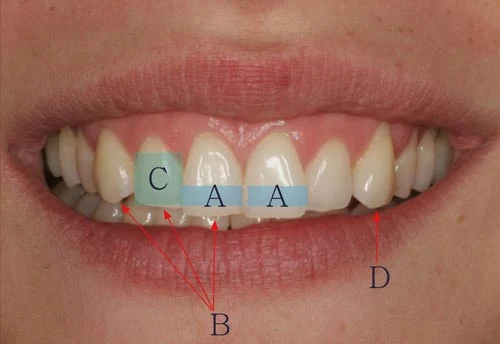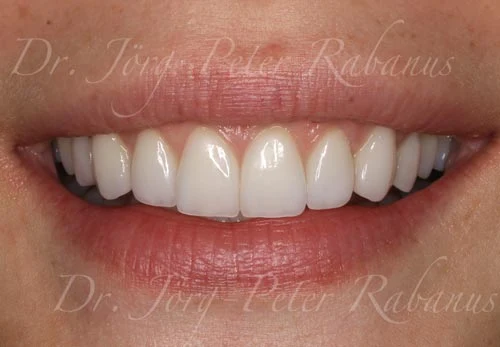Porcelain Veneers Correct A Variety of Dental Aesthetic Shortcomings
The Importance of Variation in Crafting the Best Porcelain Veneers
Porcelain veneers have become a transformative solution in cosmetic dentistry, addressing various aesthetic and functional dental concerns. While they are designed to enhance the appearance of teeth, the key to creating truly successful veneers lies in tailoring them to the unique needs and preferences of each patient. This customization requires meticulous attention to detail and an understanding of the variations that influence the outcome, including tooth structure, symmetry, translucency, and functionality.

This smile-design patient requested porcelain veneers to address a variety of dental concerns. She wanted a "prettier" smile. Her goal was to have whiter, healthier looking, yet natural teeth. She had tried various tooth whitening regimens, which had not given the result that she had hoped for. In addition, her teeth became very sensitive to the bleaching agent. In addition, she was concerned about other aspects of the appearance of her front teeth, such as dental misalignments, some wear, and lack of aesthetic harmony among her teeth.

The above image highlights the principal aesthetic shortcomings of her natural upper front teeth:
A = The two upper contral incisors are asymmetric due to misalignment, differing degrees of eruption, and uneven gum lines.
B = The three arrows point towards the incisal edges of the upper central and lateral incisors and the canines. The lateral incisor is too square-looking (C)and should be narrower relative to the central incisor.
D = The upper left canine displays a significant wear facet the cause of which needs to be diagnosed prior to the development of her smile design.

The longevity of the new smile was optimized by finding the home position of the temporomandibular joints and the way her upper and lower teeth function against each other in that position. Dr. Jorg-Peter Rabanus decided that a light equilibration of her occlusal contacts was necessary. Hence, a possible trigger to her grinding habit that produced the heavy wear facet at her upper left canine was eliminated.
Points A, B, C, and D were addressed and corrected. In addition, the patient desired playful incisal translucencies that would give her a more youthful appearance.
Personalized Aesthetic Design
Patients seeking veneers often have specific aesthetic goals, such as achieving a whiter, more harmonious, and natural-looking smile. However, creating this desired look requires more than simply applying a uniform set of veneers. Variations in tooth size, shape, and alignment must be carefully addressed. For example, as illustrated in the case of a patient with significant concerns about misalignment, uneven gum lines, and asymmetry in the central incisors, these factors cannot be ignored in favor of a "one-size-fits-all" solution.
Aesthetic nuances like playful incisal translucencies and the proportional relationship between central incisors, lateral incisors, and canines are essential to achieving a youthful, natural appearance. Failing to account for these variations can result in veneers that look artificial or fail to harmonize with the patient’s overall facial features.
Functional Considerations for Longevity
Beyond aesthetics, variations in the functional aspects of veneers are equally important. Functional alignment plays a critical role in the durability and comfort of the veneers. For instance, in the case mentioned, the patient displayed significant wear on the upper left canine, a problem that was likely exacerbated by grinding habits. Addressing such issues involves more than cosmetic correction; it requires evaluating the patient’s occlusal (bite) alignment and ensuring that the veneers do not interfere with the natural motion of the jaw.
Functional variations are not merely cosmetic concerns—they directly impact the longevity of the veneers. Proper equilibration of the occlusal contacts and addressing potential triggers for habits like bruxism are crucial steps in the veneer design process.
The Role of Advanced Materials and Techniques
The material properties of porcelain also allow for a wide range of variations in translucency, texture, and color. By incorporating these details, dentists can create veneers that mimic the natural light-reflecting properties of enamel. Such attention to detail is particularly important for patients who desire natural aesthetics while correcting issues like discoloration or wear. For example, the patient in question opted for veneers with playful incisal translucencies, which contributed to a youthful and dynamic appearance.
Conclusion
The need for variation in crafting best porcelain veneers cannot be overstated. A comprehensive approach that combines aesthetic refinement, functional precision, and material customization ensures the best results for each patient. By addressing unique concerns such as alignment, wear, and translucency, best cosmetic dentist San Francisco, Dr. Jorg-Peter Rabanus, can deliver natural veneers that not only enhance the smile but also promote long-term oral health and satisfaction. For San Francisco patients, this commitment to personalized care transforms veneers into more than a cosmetic fix—it makes them a durable and life-changing solution.
References:
Morley J. Smile Design Terminology. Dentistry Today, 1996 vol. May/June; 70-71.
Miller CJ. Esthetic Dentistry - The Smile Line as a Guide to Anterior Esthetics. Dental Clinic North Am, 1999 vol. 33 (2); 157-164.
Erics RE et al. A predictable approach for enhanced aesthetics: A case report. Pract Proced Aesthetic Dentistry, 2010 vol. 9 (2); 229-231.
Isiksal E et al. Smile esthetics: Perception and comparison of treated and untreated smiles. Am J Orthod Dentofacial Orthop, 2006 vol. 129 (1); 8-16.
Wells DJ. The Lateral Incisor: The Unsung Hero in Smile Design. American Academy of Cosmetic Dentistry Journal, 1999 vol. Fall; 38-46.
Mahshid M et al. Evaluation of "golden proportion" in individuals with an esthetic smile. J Esthetic Restorative Dentistry, 2004 vol. 16 (3); 185-192.
Ker AJ et al. Esthetics and smile characteristics from the layperson's perspective A computer-based survey study. J AM Dental Assoc, 2008 vol. 139 (10); 1318-1327.
Ritter DE et al. Esthetic influence of negative space in the buccal corridor during smiling. Angle Orthodontics, 2006 vol. 76 (2); 198-203.
Sesemann MR. The diagnostic tracing analysis--visualization by the numbers. Pract Proced Aesthetic Dentistry, 2004 vol.16 (8); 567-572.
Beall AE. Can a New Smile Make You Look More Intelligent and Successful? Dental Clinic North Am, 2007 vol. 51 (2); 289-297.
Methot A. "M" Proportions - The New Golden Rules in Dentistry. Spectrum – AACD Issue 2006; 1-6.
Wolfart S et al. Subjective and objective perception of upper incisors. J Oral Rehabil, 2006 vol. 33 (7); 489-495.
Sarver DM et al. Dynamic smile visualization and quantification: Part 2. Smile analysis and treatment strategies. Am J Orthod Dentofacial Orthop, 2003 vol. 124 (2); 116-127.
LeSage BP et al. Approaches to Smile Design - Mathematical to Artistic Interpretation. J Cosmetic Dentistry, 2012 vol. 28 (1); 126-147.
Weinstein SP. Classification of clinical attributes in tooth appearance. Pract Proced Aesthetic Dentistry, 2008 vol. 20 (3); 143-151.
Tsuzuki Y. Creating vivid life into our creations. Combining artistic sensibility with functional essentials achieves the desired outcome. J Cosmetic Dentistry, 2016 vol. 32 (3); 26-40.
Jardim da Motta AF et al. Display of the incisors as functions of age and gender. Austral Orthod J, 2010 vol. 26 (1); 27-32.
Rafael CF et al. Affecting Anterior Esthetics in All-Ceramic Restorations - Two Case Reports. J Cosmetic Dentistry, 2007 vol. 33 (3); 56-64.
Sesemann MR. Appropriate Line Angles to Optimize Smile Design Restorations. J Cosmetic Dentistry, 2007 vol. 33 (3); 66-75.
Canizares R. Creating a Beautiful Smile with Conservative Porcelain Veneers. J Cosmetic Dentistry, 2007 vol. 33 (3); 18-22.
Sisler ZS. Esthetic Dentistry Built with Sound Functional Principles. Inside Dentistry, 2017 vol. March; 57-62.
Sterrett JD et al. Width/length ratios of normal clinical crowns of the maxillary anterior dentition in man. J Clinical Periodont, 1999 vol. 26 (3); 153-157.
Chu SJ. A biometric approach to predictable treatment of clinical crown discrepancies. Pract Proced Aesthetic Dentistry, 2007 vol. 19 (7); 401-409.
Sesemann MR. Utilizing diagnostic tracing analysis for smile design. AACD Monograph, 2010; 1-4.



